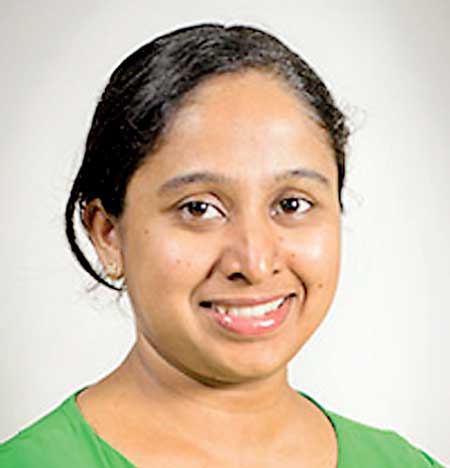Friday Oct 24, 2025
Friday Oct 24, 2025
Wednesday, 4 October 2017 00:00 - - {{hitsCtrl.values.hits}}


By Kanchana Wickramasinghe
Sustainable tourism represents numerous avenues for development in any destination and will be achieved only when its social and environmental benefits are realised, in addition to its economic benefits. This is applicable to any form of tourism, ranging from mass tourism to small scale tourism. The Sri Lanka Tourism Strategic Plan 2017 – 2020 identifies core strategies to foster sustainable tourism.
Informed decision making is a fundamental requirement in achieving these policy objectives and positioning Sri Lanka as a sustainable tourism destination in the world. This requires comprehensive information on all aspects of the tourism industry. Such information that enables effective decision making is sorely lacking in Sri Lanka. Sustainable tourism indicators are a fundamental tool which can help make information-based, effective decisions. The adoption of such indicators in a sensible manner lowers the costs associated with inappropriate tourism policy interventions. A comprehensive set of indicators have the ability to demonstrate the economic, social, and environmental issues that constraint sustainable tourism. The indicators also allow periodical monitoring of the progress in various aspects of the industry and are helpful in assessing the efficacy of various interventions.
The Sustainable Development Goals (SDGs) identifies tourism as a tool for sustainable development, and presents targets and indicators for measuring progress under three SDGs. These goals are, Goal 8 (promote sustained, inclusive and sustainable economic growth, full and productive employment and decent work for all), Goal 12 (ensure sustainable consumption and production patterns), and Goal 14 (conserve and sustainably use the oceans, seas and marine resources for sustainable development).
The tourism related indicators for Goal 8 include, tourism led GDP as a proportion of total GDP and in growth rate, and proportion of jobs in sustainable tourism industries out of total tourism jobs. The tourism related indicator in the Goal 12 deals with the number of sustainable tourism strategies or policies and implemented action plans with agreed monitoring and evaluation tools.
As the United National World Tourism Organization (UNWTO) Guide Book on Indicators of Sustainable Development for Tourism Destinations illustrates, the indicators can support effective decision making at all levels. Thus, indicators can be developed for a country, a region, specific destinations (such as coastal zones), key tourist use sites (such as beaches), tourism companies (such as tour operators), and individual tourism establishments (such as hotels). Manila Call for Action on measuring sustainable tourism, which was produced in June 2017 at the 6th International Conference on Tourism Statistics of the UNWTO, highlights the global commitment to sustainable tourism and the need for measuring it.
Though statistics on the economic aspects of tourism are currently being compiled and published, there are huge gaps in terms of social and environmental implications of the tourism industry, and insufficient information leads to incorrect decision making.
There have been some initiatives on developing Tourism Satellite Accounts (TSA) for Sri Lanka - a tool used to measure the true contribution of tourism towards the national economy. An action plan has been prepared to implement such system, as highlighted in the Annual Report 2013 of the SLTDA.
Some attempts are being made to develop national level indicators for the tourism industry in certain policy documents. The Sri Lanka Tourism Strategic Plan 2017 – 2020 presents several indicators which are relevant at national level. The plan points out the need for defining the introduced indicators and outlining parameters for each indicator. In addition, development of a baseline is crucial to facilitate periodical monitoring of certain aspects of the plan.
Besides, the tourism industry as a whole is taken into consideration when developing indicators for other sectoral policies. For instance, the National Adaptation Plan for Climate Change Impacts in Sri Lanka 2016 - 2025 identifies performance indicators of the tourism industry, in relation to adapting to climate change impacts.
The development of a comprehensive set of sustainable tourism indicators is vital, but challenging at all levels. At the sub-national levels (regions, specific destinations, tourist sites, tourism companies, and individual tourism establishments) the task is even more difficult, given the issues present and significant data gaps.
The development of a technically-sound and meaningful set of indicators to measure sustainable tourism in itself is a gruelling task. Wide data and information gaps exist with regard to environmental and social aspects. A study undertaken to measure the environmental management practices in the hotel sector in Sri Lanka revealed that majority of hotels which obtain ground water do not maintain water consumption data, as water is obtained at zero price (apart from the cost of extraction). Comparatively, energy data is more available, as they are recorded in the electricity and fuel bills. The same study found that only 37% of hotels maintain good records on environmental management aspects (energy, water, and waste).
National data mostly focuses on economic aspects. Even so, there are gaps in economic data, which can ideally be addressed through TSA. Economic indicators on sustainable tourism take a step further to formulate vital ‘processed’ information for decision making. In order to capture the important environmental and social aspects of tourism, a dedicated approach will be required to collect data. Both quantitative and qualitative indicators have to be developed depending on the availability of data and information.
The indicators presented in the Sri Lanka Tourism Strategic Plan 2017 – 2020 can be considered as a first step towards the development of a set of broad sustainable indicators at the national level. The indicators can be applied for provincial and district levels in a meaningful manner, depending on the availability of data and information. Extensive stakeholder consultations, covering all the sub-sectors and associated sectors, are a must in this regard.
(Kanchana Wickramasinghe is a Research Economist at the Institute of Policy Studies of Sri Lanka (IPS). To share your comments with the author, please write to [email protected]. For more articles, visit our blog http://www.ips.lk/talkingeconomics/)
 www.iso.org: As one of the world’s biggest economic sectors, tourism affects virtually all of us. Not only does it currently represent 7% of the world’s exports in goods and services, generating $ 4 billion a day on average), it also has a significant impact on the world we live in. Which is why making it sustainable is essential – and the theme of World Tourism Day 2017.
www.iso.org: As one of the world’s biggest economic sectors, tourism affects virtually all of us. Not only does it currently represent 7% of the world’s exports in goods and services, generating $ 4 billion a day on average), it also has a significant impact on the world we live in. Which is why making it sustainable is essential – and the theme of World Tourism Day 2017.
Last year alone, 1 235 million travellers crossed international borders in one single year. By 2030, this 1.2 billion will become 1.8 billion). Tourism represents an opportunity to make our world a better place and advance the key aspects of sustainable development – economic, social, environmental and cultural.
Today is World Tourism Day. Celebrated around the theme ‘Sustainable Tourism – a Tool for Development,’ it provides an opportunity to reflect on the contribution tourism currently makes to sustainable development and how we can take it further.
ISO has a number of International Standards that serve as important tools to help key players in the tourism industry improve their contribution to sustainable development. These include standards developed by ISO technical committee ISO/TC 228, Tourism and related services.
For example, ISO/TS 13811, Tourism and related services – Guidelines on developing environmental specifications for accommodation establishments, lays down the guidelines to help reduce the negative impacts of accommodation establishments while retaining the benefits of tourism, thus helping to conserve the natural environment and its biodiversity in the context of its specific local conditions.
The technical specification is the result of collaborative work by experts from a number of national standardisation bodies and international partners, such as the Global Sustainable Tourism Council and HOTREC.
Also in development, the upcoming ISO 20611, Adventure tourism – Sustainability good practices – Requirements and recommendations, gives adventure tourism providers the guidance they need to minimise or mitigate the negative environmental, economic or social impacts of tourism and enhance the positive ones, while the future ISO 21401 on the sustainable management of accommodation facilities sets out the requirements for a sustainability management system.